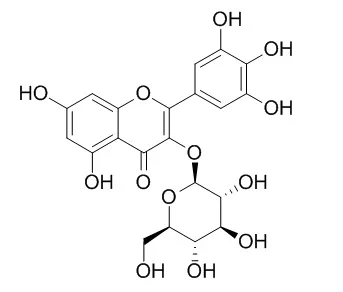| In vitro: |
| Evid Based Complement Alternat Med. 2014;2014:283938. | | Antioxidant activities and phytochemicals of leaf extracts from 10 native rhododendron species in taiwan.[Pubmed: 24987425 ] | Rhododendron, one of the most famous ornamental plants in the world, is traditionally a medicinal plant. However, the potential bioactivities of native Rhododendron in Taiwan have not been completely studied.
METHODS AND RESULTS:
In this study, the results revealed that Rhododendron pseudochrysanthum exhibited the best antioxidant activities among 10 native Rhododendron species in Taiwan. Furthermore, based on a bioactivity-guided isolation principle, nine specific phytochemicals were isolated and identified as (2R,3S)-catechin (1), (2R,3R)-epicatechin (1'), (2R,3R)-dihydromyricetin 3-O- β -l-arabinopyranoside (2), (2S,3S)-taxifolin 3-O- β -l-arabinopyranoside (2'), (2R,3R)-taxifolin 3-O- β -l-arabinopyranoside (3), Myricetin 3-O-beta-D-glucopyranoside(3'), rutin (4), hyperoside (5), and quercitrin (6). Of these compounds, 2 and 3 were found to be major bioactive compounds, and their concentrations in the n-butanol (BuOH) fraction were determined to be 52.0 and 67.3 mg per gram, respectively.
CONCLUSIONS:
These results demonstrated that methanolic extracts of Rhododendron pseudochrysanthum leaves have excellent antioxidant activities and great potential as a source for natural health products. | | J Pharm Pharmacol. 2006 Jul;58(7):981-8. | | An extract of Lannea microcarpa: composition, activity and evaluation of cutaneous irritation in cell cultures and reconstituted human epidermis.[Pubmed: 16805959] | Lannea microcarpa (Anacardiaceae) is a tropical tree used in African folk medicine and commercial dermopharmaceutical formulations.
METHODS AND RESULTS:
Fractionation and analysis of its polar extract allowed the identification of 4'-methoxy-myricetin 3-O-alpha-L-rhamnopyranoside, myricetin 3-O-alpha-L-rhamnopyranoside, Myricetin 3-O-beta-D-glucopyranoside, vitexin, isovitexin, gallic acid and epi-catechin, as the major constituents. In-vivo assay (the croton oil ear test in mice) showed that the extract had significant anti-inflammatory effect (ID50 = 900 microg cm(-2)) but ten times lower than that of indometacin (ID50 = 93 microg cm(-2)), the non-steroidal anti-inflammatory drug used as reference. Cytotoxicity and cutaneous irritation of the extract and its constituents were investigated.
CONCLUSIONS:
The crude extract and its major components did not affect cell viability in-vitro either in three different cultures (J774. A1, WEHI-164 and HEK-293) of cells grown in monolayers or in the reconstituted human epidermis (RHE, 3D model), nor did they cause release of pro-inflammatory mediators (IL-1alpha) or histomorphological modification of RHE. |
|






 Cell. 2018 Jan 11;172(1-2):249-261.e12. doi: 10.1016/j.cell.2017.12.019.IF=36.216(2019)
Cell. 2018 Jan 11;172(1-2):249-261.e12. doi: 10.1016/j.cell.2017.12.019.IF=36.216(2019) Cell Metab. 2020 Mar 3;31(3):534-548.e5. doi: 10.1016/j.cmet.2020.01.002.IF=22.415(2019)
Cell Metab. 2020 Mar 3;31(3):534-548.e5. doi: 10.1016/j.cmet.2020.01.002.IF=22.415(2019) Mol Cell. 2017 Nov 16;68(4):673-685.e6. doi: 10.1016/j.molcel.2017.10.022.IF=14.548(2019)
Mol Cell. 2017 Nov 16;68(4):673-685.e6. doi: 10.1016/j.molcel.2017.10.022.IF=14.548(2019)